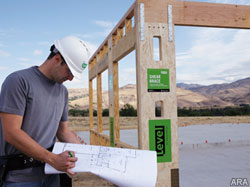(ARA) – Given this year’s big earthquakes in Haiti and Chile, smaller quakes closer to home and predictions of an active hurricane season approaching, many Americans may wonder how their dwellings would fare in a natural disaster. Whether building new, or adding on, it is important to speak with the builder about how your home will be protected from seismic activity, high winds and other perils.
Although specific natural disasters are difficult to predict, no part of the country is immune. The dangers show that careful preparation in home and other building construction is a necessity.
“It’s not a matter of if, only of when an event like this strikes the people of the United States,” says Marcia McNutt, director of the U.S. Geological Survey, commenting in USA Today on Chile’s magnitude 8.8 quake. Other hazards present additional risks. For example, six major hurricanes, on average, strike the U.S. mainland every decade, according to the National Hurricane Center, and wide swaths of the country are often subject to wind damage.
“Building codes in the U.S. are designed to reduce death and injuries from natural hazards,” says Daniel Cheney, director of codes and product acceptance for iLevel by Weyerhaeuser. “The issue is making sure cities and counties are aware of the risks and have adopted and enforced the latest codes.”
One way building codes help protect homes against Mother Nature is by requiring lateral bracing. Walls and other parts of the structure must include materials and construction techniques to dissipate lateral forces from earthquakes and wind events. Such bracing helps prevent the home from collapsing, sliding off its foundation or having walls pushed out of alignment.
Modern home designs frequently make lateral bracing a challenge. “People like high ceilings and lots of windows,” says Cheney. “Builders used to have plenty of space to add bracing, but now you see tall or narrow walls with multiple openings. Think of a house like a cardboard box with numerous holes punched in it; it’s just not as strong unless you reinforce it.”
To address this problem, manufacturers have developed pre-fabricated “shear panels” as narrow as 12 inches, compared to the 4-foot widths typically required for wall bracing built on site. One such product, the iLevel Shear Brace, is the first to be verified for compliance with the latest building codes (2009 IBC; 2009 IRC) in walls up to 20 feet high or stacked in two-story homes. (For more information on home bracing, visit www.iLevel.com or call (888) 453-8358).
“As you might imagine, getting the bracing right is critical to home safety,” adds Cheney. “Pre-fabricated shear panels are subjected to extensive testing and engineering. They really make a difference in the design options for homes. You can have light-filled open spaces with multiple windows that stand strong when the earth shakes or the wind howls.”
Courtesy of ARAcontent

